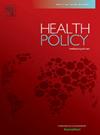未满足卫生保健需求的决定因素和相关成本及其与资源分配的关系。来自芬兰的启示
IF 3.4
3区 医学
Q1 HEALTH CARE SCIENCES & SERVICES
引用次数: 0
摘要
芬兰各县的福利服务分配公式是根据从国家登记册中收集的利用情况计算的,没有考虑到未满足的需求。我们调查了与自我报告的未满足的医疗保健需求、初级和全部医疗保健相关成本相关的因素,以及未满足需求的区域差异与基于利用的需求之间的关系。2017 - 2018年FinSote调查数据与2017年登记数据(n = 13,800)相匹配。医疗保健访问的费用被用作使用率的代理。我们使用了三个logit回归来探索与自我报告的未满足需求相关的因素,并使用了八个两部分模型来分析成本数据。开发并使用了分析权值。那些报告需求未得到满足的人是女性、失业和在外国出生的人,他们有多种发病率,自我评估的健康状况不佳。收入最高的五分之一和自我评价良好的生活质量与自我报告的未满足需求呈负相关。需求未得到满足的人每年在初级保健和全部保健方面分别额外花费32.2-183.9欧元和269.7-963.7欧元。自我报告未满足需求的区域差异与区域资源分配中使用的需求指数不完全相关。为了解释预算拨款中未满足的需求,应更广泛和常规地收集自我报告的未满足需求和生活质量数据。解决未满足的需求应被视为对初级保健的长期投资,以减少可避免的保健不平等。本文章由计算机程序翻译,如有差异,请以英文原文为准。
Determinants and associated costs of unmet healthcare need and their association with resource allocation. Insights from Finland
The Finnish counties’ allocation formulae for welfare services are based on utilisation collected from national registers and do not account for unmet needs. We investigated factors associated with self-reported unmet healthcare need and associated costs of primary and total healthcare, as well as the association between regional variation in unmet needs and utilisation-based need. The 2017–2018 FinSote survey data were matched with 2017 register data (n = 13,800). Costs of healthcare visits were used as a proxy for utilisation. We applied three logit regressions to explore factors related to self-reported unmet need and eight two-part models to analyse cost data. Analysis weights were developed and used. Those reporting unmet need were female, unemployed and foreign-born, and had multiple morbidities and poor self-assessed health. The highest income quintile and good self-rated quality of life were negatively associated with self-reported unmet need. A person with unmet needs spent an additional €32.2–183.9 and €269.7–963.7 yearly on primary and total healthcare, respectively. Regional differences in self-reported unmet need were not fully correlated with the need indices used in the regional resource allocation. To account for unmet need in budget allocations, self-reported unmet need and quality of life data should be collected more extensively and routinely. Addressing unmet need should be viewed as a long-term investment in primary care to reduce avoidable health inequalities.
求助全文
通过发布文献求助,成功后即可免费获取论文全文。
去求助
来源期刊

Health Policy
医学-卫生保健
CiteScore
6.40
自引率
6.10%
发文量
157
审稿时长
3-8 weeks
期刊介绍:
Health Policy is intended to be a vehicle for the exploration and discussion of health policy and health system issues and is aimed in particular at enhancing communication between health policy and system researchers, legislators, decision-makers and professionals concerned with developing, implementing, and analysing health policy, health systems and health care reforms, primarily in high-income countries outside the U.S.A.
 求助内容:
求助内容: 应助结果提醒方式:
应助结果提醒方式:


